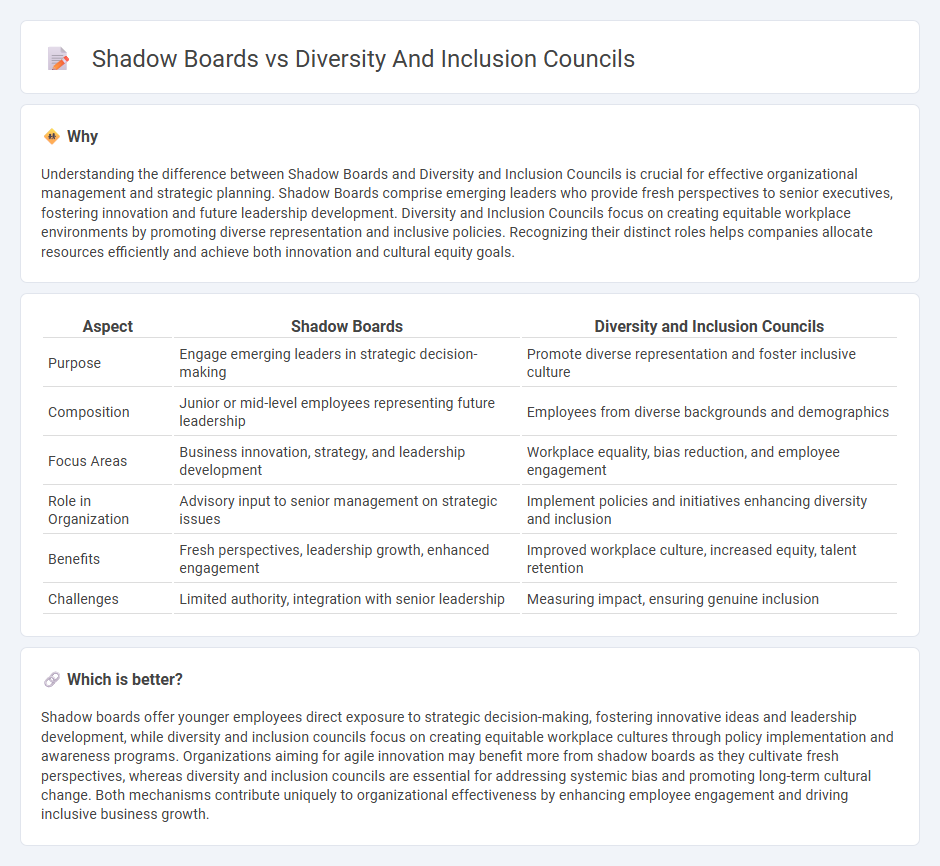
Shadow boards provide emerging leaders with strategic decision-making opportunities that foster innovation and fresh perspectives within management structures. Diversity and inclusion councils focus on creating equitable workplace environments by promoting representation, belonging, and unconscious bias mitigation. Explore how these distinct governance models drive organizational growth and cultural transformation.
Why it is important
Understanding the difference between Shadow Boards and Diversity and Inclusion Councils is crucial for effective organizational management and strategic planning. Shadow Boards comprise emerging leaders who provide fresh perspectives to senior executives, fostering innovation and future leadership development. Diversity and Inclusion Councils focus on creating equitable workplace environments by promoting diverse representation and inclusive policies. Recognizing their distinct roles helps companies allocate resources efficiently and achieve both innovation and cultural equity goals.
Comparison Table
| Aspect | Shadow Boards | Diversity and Inclusion Councils |
|---|---|---|
| Purpose | Engage emerging leaders in strategic decision-making | Promote diverse representation and foster inclusive culture |
| Composition | Junior or mid-level employees representing future leadership | Employees from diverse backgrounds and demographics |
| Focus Areas | Business innovation, strategy, and leadership development | Workplace equality, bias reduction, and employee engagement |
| Role in Organization | Advisory input to senior management on strategic issues | Implement policies and initiatives enhancing diversity and inclusion |
| Benefits | Fresh perspectives, leadership growth, enhanced engagement | Improved workplace culture, increased equity, talent retention |
| Challenges | Limited authority, integration with senior leadership | Measuring impact, ensuring genuine inclusion |
Which is better?
Shadow boards offer younger employees direct exposure to strategic decision-making, fostering innovative ideas and leadership development, while diversity and inclusion councils focus on creating equitable workplace cultures through policy implementation and awareness programs. Organizations aiming for agile innovation may benefit more from shadow boards as they cultivate fresh perspectives, whereas diversity and inclusion councils are essential for addressing systemic bias and promoting long-term cultural change. Both mechanisms contribute uniquely to organizational effectiveness by enhancing employee engagement and driving inclusive business growth.
Connection
Shadow boards provide emerging leaders with opportunities to influence organizational strategy, fostering diverse perspectives that complement the goals of Diversity and Inclusion councils. Both structures promote inclusive decision-making by integrating varied viewpoints from underrepresented groups, enhancing innovation and equity in management practices. Their collaboration drives cultural transformation, aligning leadership development with comprehensive diversity initiatives to improve overall organizational performance.
Key Terms
Representation
Diversity and inclusion councils primarily focus on increasing representation and fostering an inclusive culture by ensuring diverse voices are heard within organizational decision-making processes. Shadow boards consist of younger or less experienced employees who provide fresh perspectives and challenge traditional leadership, indirectly influencing representation by promoting diverse ideas. Explore how these two structures uniquely impact representation and influence workplace diversity.
Decision-making
Diversity and inclusion councils drive organizational equity by integrating diverse perspectives into policy and culture, enhancing decision-making through representation and inclusion. Shadow boards consist of emerging leaders who provide innovative insights and challenge executive decisions, fostering agility and fresh viewpoints in strategic processes. Explore how these structures uniquely impact organizational decision-making and drive growth.
Organizational influence
Diversity and inclusion councils primarily drive organizational change by embedding diverse perspectives into corporate policies and culture, ensuring equitable representation at all levels. Shadow boards consist of emerging leaders who provide fresh insights and innovative solutions directly influencing strategic decisions, fostering leadership development and agility. Explore how integrating both mechanisms can amplify organizational influence and transformation.
Source and External Links
Diversity and Inclusion Councils - A D&I council is a group including senior leaders that drives diversity and inclusion efforts aligned with business strategy, providing governance, accountability, and fostering real organizational change.
Diversity and Inclusion Councils | Seramount - These councils act on behalf of a company to manage D&I processes, link diversity initiatives to business goals, and ensure strategic accountability with support from senior leadership.
Councils & Committees - Diversity and Inclusion - Syracuse University - University D&I councils serve as advisory bodies providing expertise to advance institutional diversity priorities, with broad representation to coordinate efforts and enhance inclusivity.
 dowidth.com
dowidth.com